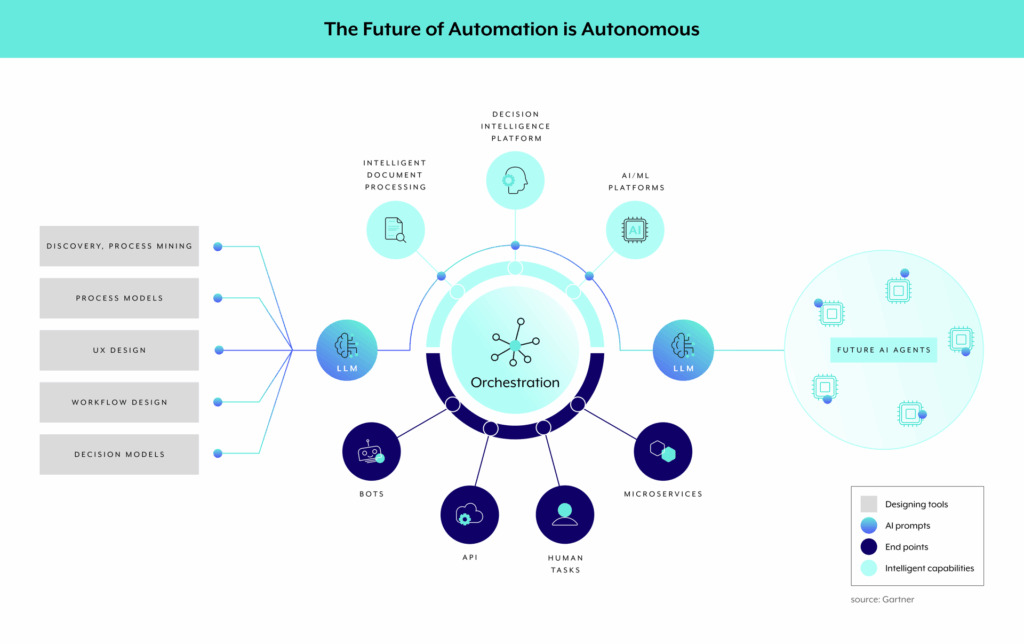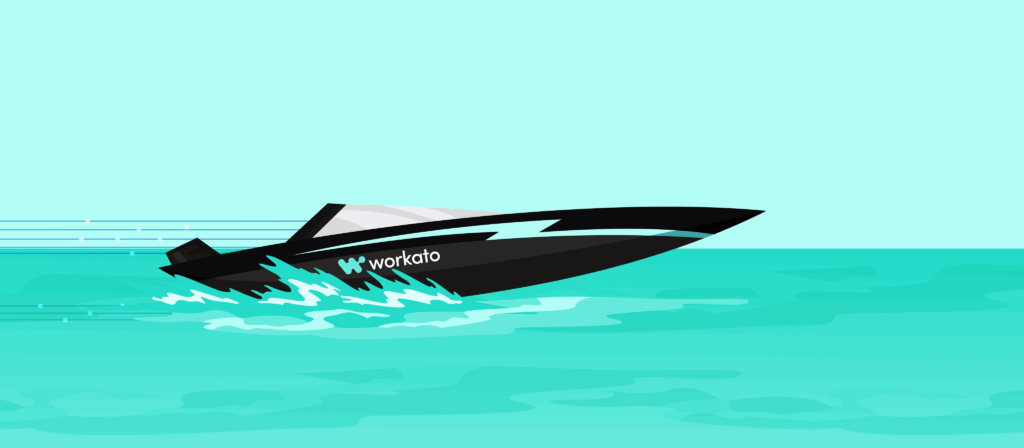What is BOAT? Business Orchestration and Automation Technologies Explained
Business Orchestration and Automation Technologies (BOAT) is now a defined market category. But for Workato, it’s not new. It’s validation. While others are retrofitting their platforms to fit Gartner’s definition, Workato has been delivering on it for years. BOAT isn’t a pivot for us—it’s what we were built to do.
A BOAT platform consolidates integration (iPaaS), low-code development (LCAP), process automation (BPA), API management, and event-driven orchestration into a single platform. It is designed to:
- Orchestrate end-to-end business processes
- Connect disparate systems and data
- Embed AI and agentic automation into workflows
- Serve both business and IT users with one unified experience
As Gartner notes in their 2025 BOAT Forecast Analysis, “spending on BOAT platforms is projected to exceed $21 billion by 2029, driven by the convergence of automation technologies and the demand for intelligent, adaptive systems.” They further state that “by 2029, 80% of enterprises with mature automation practices will pivot to a consolidated platform that orchestrates business processes and agentic automation, up from 20% today.” Workato isn’t reacting to this trend – we’re the reason it’s happening.
BOAT vs. iPaaS vs. APIM: A Strategic Comparison
To help clarify what sets BOAT platforms apart, here’s a side-by-side comparison of BOAT, iPaaS, and API Management (APIM) platforms across the dimensions that matter most to IT and business leaders:
| Capability | BOAT | iPaaS | APIM |
|---|---|---|---|
| Scope | End-to-end process orchestration + automation | System-level data and app integration | API exposure and lifecycle management |
| Architecture | Unified platform with embedded AI, LCAP, IDP, iPaaS, BPA | Middleware connecting apps | Gateway and control for APIs |
| Trigger types | APIs, events, data changes, human-in-the-loop | Mostly API/event triggers | API calls only |
| Orchestration | Native, agentic, cross-system, people + data | Light-weight or offloaded | None (relies on back-end logic) |
| Target users | IT + Business (fusion teams) | Primarily IT | Primarily developers |
| AI/GenAI embedded | Yes: prompt-driven workflows and agents | Limited | None or bolt-on |
| Use cases | HR automation, quote-to-cash, onboarding, finance workflows | App-to-app sync, data pipelines | API productization and developer portals |
| Outcome focus | Time-to-value, business agility, continuous automation | Integration efficiency | API exposure, control, monitoring |
Workato Is the Most Complete BOAT
One compelling example is Malwarebytes, a cybersecurity company that used Workato to connect siloed systems, automate usage-based billing, and improve customer renewals by 93%. By orchestrating order processing across CRM, data warehouse, ERP, and financial planning systems, Malwarebytes saved 528 hours annually – equivalent to 66 full-time workdays. As a result, their CFO now has dynamic dashboards for the company’s top 10 financial KPIs, transforming visibility and operational efficiency.
While other vendors scramble to retrofit, rebrand, or acquire their way into this category, Workato stands alone in:
- Natively combining integration, automation, and orchestration
- Powering both API and event-driven use cases
- Offering consumer-grade usability with enterprise-grade security
- Supporting IT-led governance and business-led innovation
- Embedding AI agents and GenAI throughout the platform
According to Gartner’s 2024 guidance, organizations are increasingly seeking platforms that reduce operational silos, improve visibility, and streamline the deployment of new technologies, and BOAT platforms are expected to support specialized and generative AI technologies that “enhance the capabilities for automation tools by adding intelligence, autonomy and adaptability to process execution and management.” This is exactly what Workato has delivered from day one.

Our customers don’t just automate tasks. They orchestrate entire experiences – across finance, HR, IT, customer support, and beyond. And they do it without needing separate tools, multiple vendors, or complex middleware.
Agentic Orchestration: The Future of Intelligent Applications
As enterprises look beyond simple automation to intelligent, AI-powered systems, BOAT platforms like Workato become the foundation for agentic orchestration. Gartner predicts that BOAT platforms will be essential for enabling “intelligent applications” – enterprise systems with embedded AI agents that can make decisions and take actions autonomously.
Unlike isolated AI implementations, agentic orchestration with Workato provides:
- Access to 10,000+ apps and data sources for comprehensive decision-making
- Granular, role-based access with full auditability and tracking
- Deterministic and probabilistic decisioning to handle both structured and unstructured business logic
- Human-in-the-loop governance to keep critical processes safe and compliant
This approach prevents AI from being “stuck on the edge” with trivial tasks and instead gives agents the skills to drive meaningful, enterprise-wide impact. Workato ONE is designed to power agentic transformation by providing the orchestration, governance, and trust necessary to scale AI initiatives from pilot to production.
How to Future-Proof with BOAT (and Why Workato)
The shift to BOAT platforms is underway, and for good reason. Organizations are:
- Consolidating fragmented automation tools
- Seeking faster time to value
- Embracing AI and event-driven processes
- Prioritizing collaboration between IT and business teams
But not all BOATs are created equal. Some are stitched together. Some are limited in scope. Some are still years away from delivering on the vision.
Workato is the orchestration platform others are trying to become. While they retrofit, we’ve been Business Orchestration and Automation Technology (BOAT) from day one – offering the complete system that others are still cobbling together.

